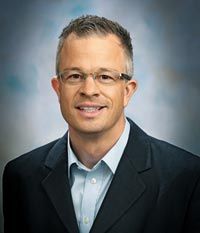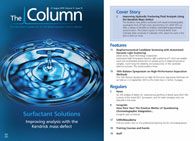Improving Hydraulic Fracturing Fluid Analysis Using the Kendrick Mass Defect
The Kendrick mass defect combined with liquid chromatography quadrupole time-of-flight mass spectrometry (LC–QTOF-MS) can offer a variety of benefits to analysts investigating groundwater contamination. The Column spoke to Thomas Borch from Colorado State University in Colorado, USA, about his work in this area to find out more.
The Kendrick mass defect combined with liquid chromatography quadrupole time-of-flight mass spectrometry (LC–QTOF-MS) can offer a variety of benefits to analysts investigating groundwater contamination. The Column spoke to Thomas Borch from Colorado State University in Colorado, USA, about his work in this area to find out more.
Photo Credit: Andrew Mackenzie/EyeEm/Getty Images

Q. Why is your group studying hydraulic fracturing flowback and produced waters?
A: Natural gas has surpassed all other fuels for energy production and unconventional shale gas is predicted to produce 49% of U.S. natural gas by 2035. Surfactants are used during hydraulic fracturing - a process in which a mixture of water, sand, and chemicals are forcefully injected into a well to break rock and enhance oil and gas extraction. They are just one group of the chemicals used in hydraulic fracturing. Oil and gas companies mix a variety of chemicals - for example, biocides, surfactants, corrosion inhibitors, friction reducers - and each company generally has its own proprietary “recipe”.
Concerns about groundwater contamination from fracturing fluids have resulted in the need for analytical techniques that can detect hydraulic fracturing chemicals and their transformation products.1,2 In addition, these new analytical tools can also be used by the industry to improve our understanding of the fate of these chemicals under downhole conditions in order to optimize the type and amount of chemicals used in hydraulic fracturing fluids.
There is also a real need to differentiate the sources of these surfactants - be it hydraulic fracturing or a wastewater plant. We believe the technique, which essentially identifies the chemical “fingerprints”, could aid those charged with monitoring water quality and even remediation efforts.
Q. What were the disadvantages of previous methods that attempted to do this?
A: The major disadvantage of previous methods was the need for reference compounds representing every single surfactant in the sample. By using the Kendrick mass defect approach and our new database only a few reference compounds are needed to positively identify hundreds of surfactants within the same group. In addition, there are no published studies of ethoxylated surfactants in environmental waters using a non-targeted accurate mass approach.
Q. For this application you decided to monitor two series of ethylene oxide (EO) surfactants: polyethylene glycols (PEGs from EO3 to EO33) and linear alkyl ethoxylates (LAEs C-9 to C-15). Can you explain why?
A: This study focused on the analysis of nonionic, ethoxylated surfactants: the same compound group that is used in household detergents and cleaners (usually labelled as “polyethylene glycol”) because they are some of the most commonly used surfactants in hydraulic fracturing fluids.
Q. What challenges did you have to overcome to analyze these compounds in water - and how did you overcome them?
A: Surfactants are ubiquitous compounds. Thus, the biggest challenge when analyzing for surfactants is to prevent contamination of the samples with surfactants. Manufacturers use surfactants in ordinary household products such as detergents, shampoos, and soaps, and they are also often present in laboratory materials such as syringe filters and gloves.
Q. What is unique about your approach using the Kendrick mass defect and liquid chromatography quadrupole time-of-flight mass spectrometry
(LC–QTOF-MS)?
A: The Kendrick mass scale, based on CH2 equaling exactly 14.0000, was developed to separate and identify a homologous series of hydrocarbons that were separated by a methylene group. It has never been applied to ethoxylated homologues. Thus, we apply a modified Kendrick mass scale, since the additive group is an ethylene unit, in combination with LC–QTOF-MS for positive identification of PEGs and LAEs.
Q. What were your main findings?
A: We successfully developed a method that can be used for source tracking of surfactants using a new “fingerprinting” approach, or that can be used to monitor water quality in areas where hydraulic fracturing is taking place.
Q. Can you comment on the use of the Kendrick mass defect and why it is important?
A: The general concept of applying the Kendrick mass scale is that if two or more compounds have the same chemical backbone but are differing by one or more “ethylene oxide” units, then they will have the same Kendrick mass defect. A Kendrick mass scaling factor can be calculated and multiplied with the accurate masses found in the total ion chromatogram to generate the Kendrick mass table. All masses that are related by an increasing unit of the ethoxylate group will have the same Kendrick mass defect and can easily be identified.
Q. Could this approach be adapted for any other applications in particular?
A: Our method was developed for the analysis (of any chain length) of PEGs and LAEs but it is likely that it can be adapted for the analysis of ionic surfactants as well as other polymeric substances.
References
1. G.A. Kahrilas, J. Blotevogel, P.S. Stewart, and T. Borch, Environmental Science & Technology49(1), 16–32 (2015).
2. E.M. Thurman, I. Ferrer, J. Blotevogel, and T. Borch, Analytical Chemistry86(19), 9653–9661 (2014).

Thomas Borch is currently Associate Professor of Environmental/Analytical Chemistry in the Department of Chemistry and the Department of Soil and Crop Sciences at the Colorado State University, Colorado, USA.
E-mail: Thomas.Borch@ColoState.edu
Website: http://borch.agsci.colostate.edu/

Silvia Radenkovic on Building Connections in the Scientific Community
April 11th 2025In the second part of our conversation with Silvia Radenkovic, she shares insights into her involvement in scientific organizations and offers advice for young scientists looking to engage more in scientific organizations.
Regulatory Deadlines and Supply Chain Challenges Take Center Stage in Nitrosamine Discussion
April 10th 2025During an LCGC International peer exchange, Aloka Srinivasan, Mayank Bhanti, and Amber Burch discussed the regulatory deadlines and supply chain challenges that come with nitrosamine analysis.
Silvia Radenkovic on Her Research and Passion for Scientific Collaboration
April 3rd 2025Silvia Radenkovic is a laboratory clinical biochemical genetics fellow at UMC Utrecht, the Netherlands and a member of Females in Mass Spectrometry (FeMS). She is currently doing a clinical fellowship where she is involved in diagnosing and helping treat patients with inborn metabolic diseases (IMD). Her research focuses on IMD such as congenital disorders of glycosylation (CDG), omics techniques such as tracer metabolomics, and different disease models.











